Executive Presence: The Art of Commanding Respect Like a CEO
Get the Key to the Boardroom with\ Powerful Executive Presence!\ “This book can be a key aid in helping you make it to the next level! Great\ coaching for anyone who is even thinking of becoming an executive!”\ Marshall Goldsmith, New York Times bestselling author of\ What Got You Here Won’t Get You There\ “On the corporate battlefield a true leader’s success is based upon his or her ability to\ communicate effectively, persuade others to follow a goal, and execute it. This leads to\ success...
Search in google:
Get the Key to the Boardroom withPowerful Executive Presence!“This book can be a key aid in helping you make it to the next level! Greatcoaching for anyone who is even thinking of becoming an executive!”Marshall Goldsmith, New York Times bestselling author ofWhat Got You Here Won’t Get You There“On the corporate battlefield a true leader’s success is based upon his or her ability tocommunicate effectively, persuade others to follow a goal, and execute it. This leads tosuccess for all. When the stakes are high, you’re well advised to read this book first.”Scott A. Gaines, vice president, Hertz Corporation“If you are seriously looking to be perceived in the light you choose, Executive Presence isthe book that not only answers the question, but shows you how to apply the answers.”Kevin Hogan, author of The Psychology of Persuasion“Harrison Monarth is a first-rate thinker who writes as clearly as he thinks.No matter where you are on the career ladder, Executive Presence will put youa step ahead of your competition.”T. Scott Gross, author of Positively Outrageous Service“Most people know that to move up in your career, you need to have self-awareness andthe ability to manage the perceptions of those whose opinions count. . . . Executive Presenceis your comprehensive guide to help you become more profi cient at self-marketing and theart of ethical persuasion to achieve your personal and professional goals.”Larina Kase, PsyD, MBA, author of The Confident Leaderand coauthor of the New York Times bestseller The Confident SpeakerAbout the BookAn expert in coaching high-level players inthe art of perception management, HarrisonMonarth reveals the critical difference betweenCEOs and those of us who wish to beCEOs. It’s not a matter of intelligence, connections,or luck. It can be summed up in twowords: executive presence.While most of us toil in obscurity and expectgreat things to follow, those on the path tocorporate leadership spend their time perfectingthe types of leadership communicationskills that generate respect and get others toshare their vision. They use these skills toestablish how they are perceived by others andto manage their reputation throughout theorganization. In other words, these soon-tobetop players have developed the presenceof an executive through careful imagemanagement—and they make sure they havethe goods to back it up.In Executive Presence, Monarth shows how youcan seize control of your own career using thesame skills. Inside, he explains how to: Accurately “read” people andpredict their behavior Influence the perceptions of others Persuade those of opposing viewsto your side Create and maintain a personal“brand” Manage and control your onlinereputation Perform damage control whenthings go wrongMonarth’s conclusions aren’t based solely onhis keen insight and extensive experience;they’re the result of the latest scientifi c researchin interpersonal communication andhuman behavior.Talent and skills are important, but they alonewon’t take you to the top of your organization.People reach highly infl uential positionsbecause they deeply understand the powerof perception and know how to leverageit in their favor. The good news is, anyonewith the will to succeed can do it. ExecutivePresence provides all the techniques you needto take your career to the highest level ofany organization.
Executive Presence\ The Art of Commanding Respect Like a CEO \ \ By Harrison Monarth \ McGraw-Hill\ Copyright © 2010 Harrison Monarth\ All right reserved.\ ISBN: 978-0-07-163464-9 \ \ \ Chapter One\ The Natural Laws of Perception: How the People around You Perceive You \ We are at our core a society of pitchers. No, we're not talking baseball here, though we all certainly wind up and deliver—and, on a regular basis, square off against—the occasional metaphoric curveball, brush-back, and unfairly called third strike. Pitching—the kind that pleads a case and asks for the order, that wraps an agenda within a message and ties a neat bow of sincerity around it—is the very essence of commerce, the lifeblood of law and politics and romance (closely aligned endeavors that they are), the fundamental stuff of human interaction.\ We pitch our beliefs and our dreams to our children. We pitch our qualifications at job interviews. We plead our case in courtrooms and at bars over drinks. We manage employees by pitching them our wisdom and our vision for the future. Our leaders pitch to us every election year with more sliders and screwballs and split-fingered high heat than any reasonable spring training can or should accommodate. We are pitching when we sell, when we lobby, when we complain, and when we seek to be heard and understood, which for most of us happens each and every day.\ That particular common denominator—being understood—is where the asterisk appears among the universe of people communicating with one another. All pitches, and more aptly all pitchers, are not created equal, and the most persuasive among us, those who continually close the deal and get the nod and generally seem to skate through life without a fallen tree on the road, much less an audit, know something the rest of us don't. They know that the art and craft of communicating do not arise from the same base level of human instinct as do walking and laughing and that taking it for granted or, worse, failing to understand and factor in the dynamics of successful communication is a recipe for randomness and mediocrity. This is precisely where the old adage "you win some and you lose some" comes from. Somebody doesn't get it because somebody else does.\ In short, consistently successful communicators—whether sales professionals, politicians, lawyers, managers, parents, partners, or coaches—know how to manage and influence the way they are perceived. More than that, they understand that it is perception, not intention or even content, that dictates the outcome of an agenda that resides at the heart of each and every pitch we make. We don't—or shouldn't—talk to hear ourselves speak; we always have information to convey, a point to make, an opinion to sway, a decision to influence, an outcome we seek to manifest. Even if we are simply commiserating or analyzing, there is an agenda in play, at the heart of which is the desire to be understood and be taken seriously by those who can help us along our career path.\ In essence, we are always pitching and have been since our first cries for food or attention were shrieked from the crib. For those who wish to improve their pitching proficiency by learning to control the way they are perceived, certain principles and natural laws make the learning curve both accessible and intuitively easy to ascend.\ The Path to Perception\ The way we are perceived by those who experience what we say or do or even our mere presence is the product of a specific neurological process whose outcome can take any number of forms. Information is taken in by one or more of five sensory portals—the senses—and then is filtered or processed by a suite of specific mental mechanisms that assign meaning and nuance to what has arrived through the senses, each with very different criteria and experiential rationales. From there, the information in its new, processed form—in other words, the way it is perceived—is deleted, distorted, or generalized, leading to a response that is manifested as an outcome.\ That response, science tells us, has as much to do with the emotional state prompted by the way information is processed as it does with the content of the information. You may not think you like a certain type of food, but if smelling it unexpectedly makes you hungry—a direct contradiction to your experiential basis and learned bias—you may decide to take a risk and go for it. The same thing goes for accepting a meeting or placing your vote or adopting a philosophy. All bets are off because the line between input and output is anything but straight and is not remotely simple. This is the source of our opportunity as communicators, because if we know what we're doing, we can be the architects of that line.\ Clearly, perception involves a lot more than listening. There are five means of input, followed by five means of filtering or processing the incoming information, leading to three possible outcomes, each of them the result of a bottom-line perception. Although deletion and distortion are rarely desired outcomes, generalization isn't necessarily bad, especially if you've positioned your message to be perceived to be correct, good, attractive, and valuable. However, nothing is certain in the sensory process, and one person's silk purse can, however inconceivably, be transformed into another's sow's ear as it navigates the harrowing process of filtering in the mind of the observer. For example, someone with a long-standing penchant for ethnic food—an experiential filter—may respond favorably to a recommendation for a new Mexican restaurant in town, whereas someone else with a different experiential filter hearing the same recommendation, even though he or she also enjoys ethnic food, may send out for Chinese instead. "To each his own" has never been truer than it is when it refers to the way people filter information.\ However, good outcome or bad, you can't get to the result you want without passing through the often rusty gate of human perception with all its pitfalls. The good news is that if you do it right, you'll find inherent opportunities. Because no two people bring the same set of criteria—tastes, biases, experiences, and preferences—to the process of filtering information, identical sets of information can have very different outcomes among different recipients; that is why some people like country music and others prefer jazz. The more you know about your target audience, the more you can apply your working knowledge of the perception process to the generation of a favorable outcome.\ How Messages and Signals Enter Our Awareness\ It isn't enough to write off the way people take in information as a function of the five senses, because what doesn't look good or sound good on the surface may lead to an unexpected outcome after that information has been filtered. It is important to understand how all the senses can, to some extent, become arrows in the quiver of an enlightened communicator. Let's face it, unless we're serving appetizers while we make a pitch, taste isn't the first sense that comes into play.\ Every day thousands of people are pulled over for speeding. Nearly every one of them says the same thing, some version of "Gee, I wasn't aware I was going too fast" or "I'm so sorry, but I'm late for [insert an empathy-eliciting excuse here]." The evidentiary facts are always the same—they were driving over the speed limit and they have something to say in their defense—and that raises the question of how some of them get off with a warning and others drive away with a ticket. Same laws, same violation, different outcomes. The explanation resides in what is not the same: different law enforcement officers who bring different biases and experiences (not the least of which is their mood at the moment), different pitches delivered with varying levels of skill, and a vast matrix of different tones, visual modes, and smells (think alcohol, perfume, body odor, etc.).\ Chances are that someone dressed nicely with a humble countenance driving a nice car—not too nice, though, because a Ferrari might threaten the ego bias of the working-class officer—who doesn't reek of martinis and makes a sensible pitch, with a little luck thrown in (luck in this case being the mood of the officer, over which the pitcher has no control), has a better chance of a good outcome than does someone with an equally sensible pitch driving a 1980s dented car painted with gang signs with expired plates while wearing a death metal graphic T-shirt and listening to a Snoop Dog CD with the scent of illegal herbs wafting from the window. These are blatantly obvious triggers of perception, but you get the point: The pitch itself is almost totally dependent on the vehicle (in this case literally) of delivery. Before you leap to generalize these cues, you should realize that for some officers they may be the very things that elicit their empathy and prompt them to let the driver off with a warning. Yes, Snoop Dog has legions of fans, and some of them are cops.\ Regardless of which mode of entry the target uses to gather information from the communicator—visual, auditory, kinesthetic (touch or pressure), smell, or taste—it all proceeds to the next step in the same fashion: It gets filtered. However, the mode of entry is indeed a factor in the outcome because it triggers the filtering process in ways that influence the outcome. The more personal the communication is, the more this is true. Touch and scent are big players in an exchange between lovers, friends, family members, and massage therapists, whereas they are barely on the map in a business meeting (other than a firm handshake and a compassionate touch to the elbow), town hall gathering, or presidential debate, where visual and nonverbal cues meld with auditory input to brand the message as credible or otherwise, depending on the bias of the listener.\ The world watched John McCain and Barack Obama square off on television in the presidential debates, and what people saw swayed many votes. Regardless of the content of their words, both men often added value (and in some cases created a negative bias) by virtue of how they said what they said: everything from the looks on their faces, to the rolling of their eyes, to the timing of an impatient grin-and-bear-it contrived smile. Obama was generally cool under fire, and McCain obviously was steaming below the surface. In the first debate McCain refused to make eye contact with his opponent, and that spoke volumes to many viewers. McCain's continued reference to viewers as his "friends" triggered millions of subconscious bias programs globally, not to mention the punch lines of late-night television hosts. Minds were changed and votes were won on both sides as much for the content of their style as for the words they delivered, because human beings have been known to evaluate character more on the basis of style than on that of content.\ It is interesting to note the change in McCain's verbal style and nonverbal cues in the second and third debates, primarily in the context of the reasons discussed here: Someone sat him down and schooled him in the wisdom of managing the perceptions he was eliciting in his audience with his impatient, intolerant tough-guy countenance. Rising executives and other professionals can learn to avoid similar initial misperceptions by reflecting on the notion that most people want to work with or for someone—that person's competence and intelligence being a given—with social acuity and a generally pleasant disposition toward others, matters of disagreement notwithstanding. Although first impressions aren't necessarily written in stone, changing an established bias—this is critically important for all communicators to understand—is orders of magnitude more difficult than winning approval from an objective, nonbiased audience. In this case the bias included the party affiliation of the candidates, and for this reason among others, Barack Obama proved triumphant. The election was won on perception as much as anything else—both personal and party—and all of it entered our collective mind through the senses. That was when the filtering began.\ What You're Up Against: Filters, Lenses, and Other Influencers That Distort Your Message\ We have complete control over what audience members take in through their five senses. We dress ourselves, we choose what to say and how to say it, and we have entire cosmetics counters full of scents from which to choose; the mode and method of our touch are up to us, and as far as taste goes, use your imagination. The way each of those choices and their combination is perceived, however, is something over which we have absolutely no control, because that perception resides in the mind—the processing function—of the beholder, which in this case is the audience. A custom-tailored designer suit may work well in the boardroom, but it won't serve you during an interview for a programmer position at Google. The best we can do is try to understand the various filters into which sensory input flows and then optimize our choices on the basis of what we know and perceive about the target audience.\ Five separate categories of filtering take place when sensory information arrives. All five connect to the five senses; for example, one's memories are applied equally to any and all of the five sensory inputs. From the field of neuro-linguistic programming (NLP) we learn that they are meta programs, belief systems, values, memories, and past decisions. Any one of these can derail your agenda, and not always for reasons you can comprehend or that make sense to you. Take the filter of memory, for example. All you have to do is bear a striking resemblance to someone's abusive former manager, and just about anything you say stands a good chance of deletion before you get out of the proverbial batter's box.\ Meta programs involve the way people think as well as the way they approach how they think. Analogously to a computer, think of a meta program as the operating system of a person's brain, software that controls the applications that do all the real processing of incoming data. This means that the other filters—beliefs, values, memories, and past decisions—are all applications that are controlled by the operating system: the meta programs. Some people are deep thinkers; others quickly respond to surface appearances. Some people procrastinate; others go all-in quickly. Some value substance over style; others value style over substance.\ The line between a meta program and a belief system can be murky: Is racial prejudice a meta program or a belief system? Both exert influence over incoming sensory input, leading to a bottom-line perception. The fact is that it doesn't matter whether it's a meta program or a belief system. What does matter is that you, as the communicator, bring a sense of how a person thinks and reacts—that person's meta programs—to the planning and execution of your pitch, your message. There are no good or bad meta programs per se; they are only the triggers that influence ensuing thought, which may or may not overturn a meta program's initial context. A meta program is not perception; it is nothing more or less than the way a person handles information, a definition of how perception will occur.\ Belief systems are a can of worms. They represent a view of the world, what a person holds as true and unquestionable. Management and union leaders often clash over disparate belief systems, and the same thing can apply to environmental activists and manufacturing executives. Belief systems include deeply rooted programming that define one's worldview; they set the parameters of right and wrong and write one's personal textbook on preferences.\ Belief systems include religion, cultural norms (and, for lack of a better term, abnorms), prejudice, educational experiences, biases, and hardwired preferences and usually stem from some combination of childhood mentoring and personal experience. They are the product of a lifetime of emotional and intellectual evolution, not always in what the masses consider the right direction. Belief systems give answers and fill the holes in what otherwise might be considered debatable or at least not provable, and because of that you and your agenda stand little chance of toppling a lifelong cherished belief. It is better to factor a belief system into your pitch and work around whatever stands ready to behead your objectives. The more you know about what enables people to make their decisions, as well as what stops them from making decisions they'd otherwise consider, the more effective you will be in crafting communications strategies that stand a chance of working.\ Closely aligned with belief systems is the filter of personal values. Values grade things as good or bad, worthy or unworthy, appropriate or inappropriate, and dictate a memo defining how one should feel about the sensory input being processed. This feeling creates a perception, and from that perception an emotional state is manifested that leads to the ultimate disposition of the information. Anger and disgust get you deleted; excitement gets you the deal.\ (Continues...)\ \ \ \ \ Excerpted from Executive Presence by Harrison Monarth Copyright © 2010 by Harrison Monarth. Excerpted by permission of McGraw-Hill. All rights reserved. No part of this excerpt may be reproduced or reprinted without permission in writing from the publisher.\ Excerpts are provided by Dial-A-Book Inc. solely for the personal use of visitors to this web site. \ \
Introduction Chapter 1: The Natural Laws of Perception: How the People around You Perceive You and Your Messages• What You’re Up Against: Filters, Lenses and Other Influencers that Distort Your Message• How Messages and Signals Enter Our Awareness• How to Communicate for Maximum Impact and Accurately Transmit the Message• Perceptual Acuity: How to Accurately Perceive Messages from OthersPART ONE: Influencing People and Events – The Foundation for Success in All Communication Chapter 2: Developing Your Social Intelligence• Social Intelligence: Buzz Word or Survival Skill? • Doing a 360 - How to Effectively Assess Your SIQ (Social Intelligence Quotient)• The 7 Keys to Social Intelligence• How to Boost Your Social Intelligence Quotient in Only 7 DaysChapter 3: How to Read People and Predict Behavior • The Top 5 Myths About Interpreting Human Behavior• How to Become a Human Message Decoder• Learn How the Pars-Pro-Toto Principle Can Help You Avoid Misjudging Others • How to Avoid Being Blinded by the Halo-Effect• Mastering Values and Criteria Analysis to Find Out What Matters to Someone Else • Secrets from the FBI's files: Catching Liars in the Act• What Are They Really Thinking? Become an Expert at Reading Body LanguageChapter 4: Engineering Buy-in and Gaining Compliance • Getting Their Attention and Keeping It – Why It's Harder Than You Think, and What You Can Do• What You Need to Know About How People Really Make Decisions• Understanding Human Desire, and How It Can Help You Get What You Want • Establishing a Strong Interpersonal Connection With Just About Anyone• How to Inspire and Motivate People for the Long HaulChapter 5: Master the Art of Storytelling for Personal and Professional Success • Why People Are Influenced by Stories • How to Load Stories with the Key Emotional Ingredients and Engage an Audience's Emotions Through the Story• Learn to Structure Stories for a More Powerful Effect on Your Listeners • Use Stories to Inject Humor and Likeability Into Your Communication: Yes, You Can Become Funnier • Enlivening Your Speeches with a Fitting Personal Story • The 5 Storytelling Techniques That Help You Convey Complex Ideas Easily and Persuasively • How You Can Use Stories to Motivate Your Audience to Support Your Goals Chapter 6: Shortcuts to Influence - The Secrets to Changing Behaviors and Attitudes Fast • Can You Persuade Without Manipulating? Recognizing Attempts at Manipulation in Yourself and Others• Navigating the Gray Areas of Persuasion and Influence• Powerful Insights into What Makes People Change Their Behaviors, Attitudes and Beliefs • Ten Powerful Techniques You Can Use Right Away to Get What You Want Without Violating Your Conscience Chapter 7: Secrets to Managing Interpersonal Conflict and Improving Strained Relationships • Common Causes of Interpersonal Conflict • How to Recognize and Prepare for Brewing Conflicts • Good Conflict vs. Bad Conflict • Ten Powerful Ways to Resolve Negative Conflict, Restore Harmony and Strengthen Interpersonal Rapport• Don't Be All Ears – The Fine Art of Listening• How to Use the Power of Empathy to Build Relationships• How to Nurse a Strained Relationship Back to HealthChapter 8: How to Hold the Conversations Nobody Wants to Have • The Anatomy of a Difficult Conversation• Preparing Effectively for the Difficult Conversation• Why a Clear Objective Will Make Your Conversations Stronger and Obtain Results• How to Deal with Emotional Outbursts and Negativity in Conversations• How to Ask the Questions that Build Receptivity and Trust • Voice Power: Why Your Vocal Tonality Can Mean The Difference between Conversation Success and Failure• How to Use Body Language to Send a Message of Compassion, Empathy and Respect• How to Summarize Your Conversations for Maximum Impact and Positive Conclusions PART TWO: A Brand Is a Promise – What Does Your Personal Brand Say? Chapter 9: Why Self-branding Is No Longer a Choice: And What Your Brand Says About You • The Difference Between Random and Controlled Branding • Start Thinking “You, Inc.”• How to Develop Yourself Into a Compelling Brand• How to Maintain and Grow “You, Inc.” and Build on Your Success• What to do When Your Personal Brand Takes a Hit Chapter 10: Branding 2.0: How to Use the Internet to Build and Expand Your Personal and Professional Brand • Have You Heard of Tela Tequila and Dan Cook? Two Case Studies on How Real-World Superstars Are Created Online• How You Can Take Advantage of Social Media like YouTube, MySpace, Facebook and Others While Avoiding the Traps• The Future Is Archived: How to Build a Consistent Brand that Keeps Building on Itself• How to Come Up With New Ideas that Keep Your Brand Humming Online PART THREE: The Age of 24-hour Media – If You’re Not “On,” You’re Out Chapter 11: How the Media Creates Meaning in the Minds of Your Audience: Powerful Messages and the Art of Spin • Learn from the Strategies of Top Communications Professionals • Spin: Why There Is No Such Thing as Unbiased Communication, and How Everything We Say Creates Meaning • Lessons in Spin from Frank Luntz, Wal-Mart, and BP• Practicing the Art of Spin: Your Turn to Create Meaning via the Persuasive Rewriting Exercise Chapter 12: How to Use the Media to Enhance Your Reputation and Raise Your Profile • Why You Need the Media• Know the Objectives: Yours and Theirs• Choosing the “Right” Media to get Your Message Out • It’s a Sound-byte World: How to Craft Compelling Quotes and Messages That Cut Through the Noise and Stand Out• Can You Play in the Big League? How to Get on CNN, Oprah and TODAY Even When You’re Just Starting Out• How to Master the Art of Q & A: Top Ten Techniques for Responding to Difficult Questions and Enhancing Your Credibility• Turning the Tables: How to Take Control of a Media Interview that Has Veered Off Course• What Questions to Ask Prior to the Interview• The Importance of Grooming and OutfitChapter 13: Top 10 Secrets for Success with the Media • Everything You Need to Know to Turn Media Opportunities into Public Relations and Business SuccessPART FOUR: Reputation Management – Your Good Name Is All You Have Chapter 14: You’ve Been Googled – What’s the Verdict? • How the Innocent Can Take a Beating on Google: a Case Study• Why the Search Engines Can Make or Break Your Reputation and What You Can Do to Influence Public Perception• The Top 10 Most Common Mistakes People Make to Sabotage Their Reputation How You Can Avoid ThemChapter 15: Reputation Management 2.0 • The Top 5 Misconceptions About a Crisis Situation and Major Threats to Your Reputation• Crisis Intelligence 101: How to Recognize the Many Faces of a Potential Crisis• Dealing with a Crisis: How to Prevent the Smoke from Becoming a Fire• Reputation in Peril: Quick Steps to Effective Crisis Management• Top Strategies to Protecting Your Good Name• Crucial Lessons from Movers and Shakers in the World of Politics and BusinessChapter 16: When the Damage Is Done – Repairing Your Reputation, Regaining Credibility and Trust • Objectively Assessing the Damage • Why You Need to Know Exactly Who Got Hurt, How and Why• How Rumors Are Created and How You Can Stop Them Before they Spin Out of Control• How to Identify Allies and Strategic Partners for Your Comeback• Designing Your Credibility Comeback Plan Step-by-Step – Ten Secrets to Rebuilding Your Credibility• You Can't Go Back – How to Reposition Yourself for Future Success • How to Keep the Trust You’ve Worked So Hard to Get Conclusion








